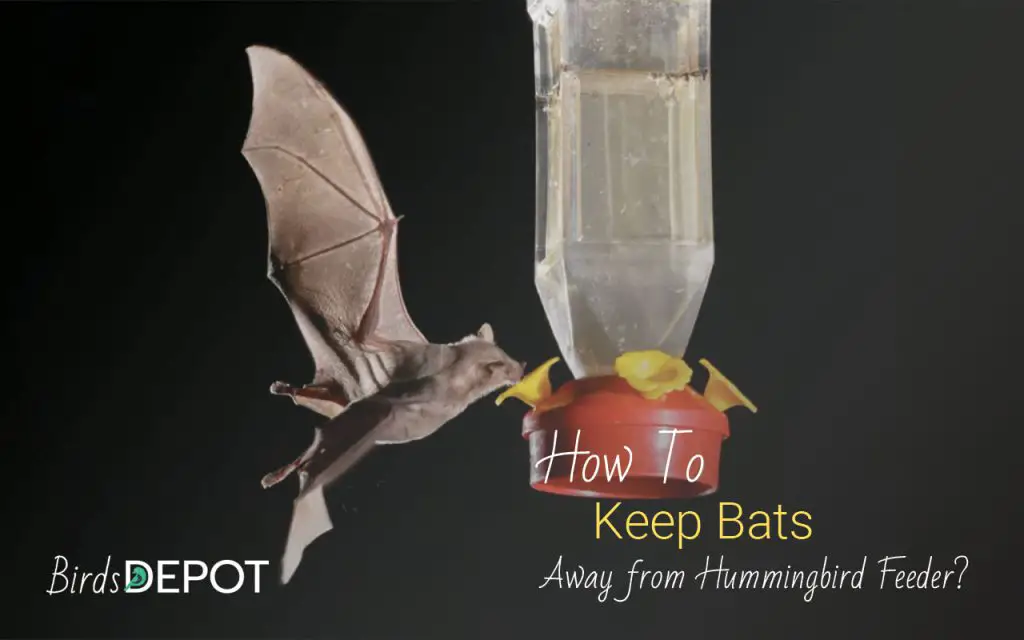Bats can drain the feeder, leaving little nectar for hummingbirds.

As a devoted bird enthusiast, there’s nothing as delightful as watching hummingbirds gracefully flit around your garden or balcony. So, have invested in hummingbird feeders to attract these tiny, colorful birds. But if you’ve experienced nectar feeders attracting hummingbirds and bats. Bats are nocturnal animals that can raid your hummingbird feeder at night and drain the sugary drinks, leaving nothing for your hummingbirds in the morning. In this article, we will explain why bats are attracted to hummingbird feeders and how to deter them from eating the nectar.
Why Bats Are Attracted to Hummingbird Feeders
Bats are attracted to hummingbird feeders due to the sweet nectar. Unlike birds, bats are active at night and have a strong sense of smell. They can pick up the scent of nectar from a distance, guiding them to the feeders. According to a study in Ecology and Evolution, bats’ love for sugar sources is a result of their natural hunting habits, making hummingbird feeders an irresistible treat.
Do bats visit hummingbird feeders at night?
If you live in North America, you do not need to worry about bats raiding the feeders. These bats like to eat insects and avoid or rarely visit a hummingbird feeder. These bats are important pollinators and play a vital role in the ecosystem. They help plants reproduce, diversify, and disperse seeds that can grow into new plants.
However, if you are located in the southwest, you will notice that bats enjoy nectar from hummingbird feeders. The lesser long-nosed bat and the Mexican long tongues bat are the nectar lover common species. According to research, a Mexican long-tongued bat can consume around 0.67 oz nectar in 106 minutes and assume what happens when a flock of bats raids a feeder.
Types of bats that are attracted to hummingbird nectar
The lesser long-nosed bat and the Mexican long-tongued bat are two types of bats attracted to nectar from hummingbird feeders. They belong to the family Phyllostomidae, which includes more than 150 species of bats that feed on fruits, nectar, insects, or blood. These bats have long noses and tongues that help them reach the nectar inside the flowers or the feeders. They also have adaptations such as reduced teeth, enlarged salivary glands, and specialized digestive enzymes that allow them to process the sugar-rich nectar. These bats are found in Mexico, Central America, and parts of the southwestern United States.
How can you tell bats are raiding your hummingbird feeders?
The easiest way to detect that bats is finishing the nectar by eating habits. Generally, you notice that hummingbirds take several days to finish the nectar from the feeder, but overnight it gets empty, which means bats raid the hummingbird feeder.
Also, if the hummingbird’s feeder gets empty at night, it means most probably only bats can do this task as they are nocturnal, which provides that spooky reputation. But you do not need to worry about anything except the empty feeder if bats take nectar.
How Do Bats Find a Hummingbird Feeder?
Bats are remarkable creatures with unique abilities that enable them to find food sources like hummingbird nectar with surprising precision. Let’s explore the fascinating ways in which bats find hummingbird feeders:
- Keen Sense of Smell: Bats are known for their exceptional sense of smell. They can detect odors and scents in the air, making it relatively easy to locate food sources, including the sweet nectar in hummingbird feeders. Even from a considerable distance, bats can pick up the scent of the nectar, drawing them closer to your feeder.
- Echolocation: Echolocation is one of the most remarkable features of bats. They emit high-frequency sound waves that bounce off objects in their surroundings. Bats can create a mental map of their environment by analyzing the echoes. This ability allows them to navigate in complete darkness and locate small objects, such as insects or the feeding ports of a hummingbird feeder.
- Visual Detection: While bats are primarily nocturnal and rely on echolocation and smell, they also have relatively good night vision. If your hummingbird feeder is well-lit or illuminated by moonlight, bats may visually spot it from a distance. However, their vision is less acute than their other senses, so they often rely on a combination of methods.
- Previous Experience: Bats are highly adaptable and can learn from previous experiences. If a bat has successfully fed from your hummingbird feeder before, it will likely remember the location and return to it. This learned behavior can lead to repeated visits by the same bat or even attract other bats to the same food source.
- Social Cues: Bats are social animals and often communicate with each other about food sources. If one bat in a colony discovers a hummingbird feeder, it may share this information with its fellow colony members. This can lead to multiple bats converging on your feeder.
- Attraction to Sugar: Like many animals, bats are naturally attracted to the high sugar content found in hummingbird nectar. Their taste receptors can detect the sweetness, making the nectar an enticing food source. Bats are drawn to hummingbird feeders because of their attraction to sugar.
How to Deter Bats from Hummingbird Feeders
Here are some of the practical and effective ways to keep bats away from hummingbird feeders:
1. Taking down the feeders at night
Take down the feeders at night and back them up in the morning. This is the simplest and most reliable method to prevent bats from accessing the nectar. Since bats are active at night and hummingbirds are active during the day, you can avoid conflict by removing the feeders when one group sleeps and returning them when the other group is awake. However, this method may have some drawbacks, such as missing out on early morning hummingbird activity or forgetting to take down or put up the feeders.
It’s important to note that if you’re unable to wake up early in the morning, it’s best to avoid this method. Otherwise, you’ll miss out on the hummingbird traffic in your yard. This is because hummingbirds typically start feeding on nectar about 20 minutes before sunrise and need to consume around 25% of their daily food and nectar intake in the morning.
2. Covering the feeders with a cloth or a net at night
Covering the feeders with a cloth or a net at night can prevent bats from accessing the nectar ports by creating a physical barrier. You can use any light material to not damage the feeder but strong enough to not be torn by the bats. You can also secure the cover with clips or ties to prevent it from blowing away. However, this method may have some challenges, such as finding a suitable cover that fits your feeder or removing and replacing it every night.
3. Using feeders with bee guards
Hummingbird Feeder with Built-in Bee Guards
The bee guards ensure that only hummingbirds can access the nectar.
Using feeders with bee guards on the feeding ports will make it harder for bats to reach the nectar by creating a small opening that only hummingbirds can access with their long and thin bills. You can also buy or add feeders with bee guards to your existing feeders. However, this method may have some limitations, such as not being 100% effective or compatible with all feeders.
4. Adjust Feeder Placement – Hang Them High
To prevent bats from visiting your hummingbird feeders, it’s important to position them strategically. Place the feeders at least 12 feet above the ground and away from any overhanging branches. Despite being good climbers, bats are less likely to reach feeders that are higher up. One birder, Sarah from Indiana, found that moving her feeders to a higher spot on her balcony significantly decreased bat visits. However, this method may have some factors to consider, such as avoiding direct sunlight, strong winds, or predators.
5. Install Bat House
A good option is to install bat houses on your property far from the hummingbird area. This provides an alternative roosting place for bats and diverts their attention away from your feeders. In a case study conducted in Texas, bat houses reduced bat interference with hummingbird feeders by 80% within a month.
North States Bat House
The interior walls of the chambers are grooved, providing a safe place for bats to roost and climb. The base features landing skerfs and three cozy roosting chambers.
6. Adjust Nectar Formulation
Tweaking your nectar recipe can make it less attractive to bats while still providing nutrition to hummingbirds. To achieve this, decrease the sugar-to-water ratio in your formula.
7. Introduce a cage

If you want to stop bats from getting in the way of hummingbirds at a feeder, you can use a cage that creates barriers for bats but doesn’t stop the hummingbirds. The grill gap of the cage should be no more than 4 inches, which will make it tough for bats to enter due to their long wingspan.
8. Introduce diferent feeder
If you do not feed bats and only prefer hummer, go with Hummzinger. It features small plastic nipples that allow hummingbirds’ sharp beaks to pass through while preventing bats from sticking their soft tongues through.
Having these bats in your backyard can also have some benefits for you. Bats can control insect pests that may damage your plants or bother you with their bites. Bats can eat up to half their body weight in insects every night. Some bats can also eat fruits and seeds, providing additional food sources for other birds in your backyard. Introduce a separate feeder for bats and place a large nectar capacity feeder away from hummingbird feeders at a lower height. A 32 oz hummingbird feeder is an excellent choice.
In this article, we have provided information on why bats are attracted to hummingbird feeders and ways to prevent them from consuming the nectar. We hope the solutions and suggestions we have offered will be helpful to you in your own backyard. Additionally, it is important to appreciate the advantages of having hummingbirds and bats in your backyard and their ability to coexist peacefully. Please share any feedback or experiences in the comments section below. Enjoy observing the birds!

